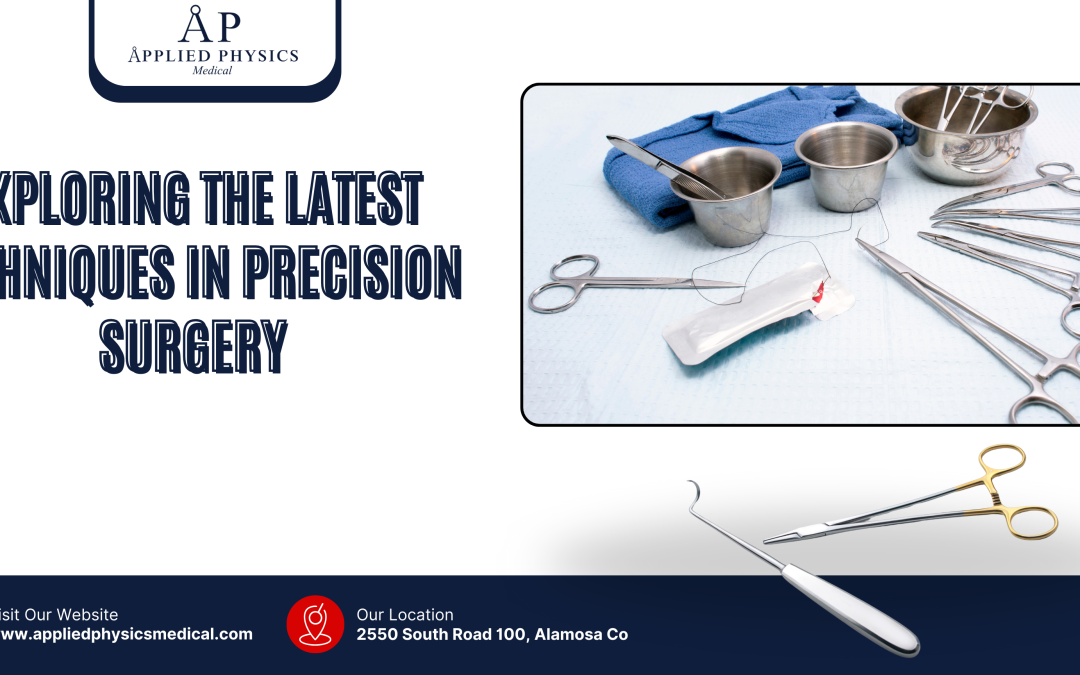Introduction
Precision surgery, or minimally invasive surgery, is a cutting-edge medical technique that allows surgeons to perform complex procedures with greater accuracy and minimal damage to surrounding tissues. This approach has revolutionized the field of surgery, offering patients faster recovery times, reduced pain, and lower risk of complications. Precision surgery encompasses a range of advanced technologies and techniques, including robotic-assisted surgery, image-guided surgery, 3D printing, and nanotechnology.
These innovations have transformed the way surgeons approach a wide variety of procedures, from orthopedic surgeries to neurosurgery and beyond. One of the key principles of precision surgery is the use of advanced imaging techniques to guide the surgeon’s movements and ensure the most accurate results possible. This has led to the development of image-guided surgery, which uses real-time imaging to provide the surgeon with a detailed view of the patient’s anatomy during the procedure.
This technology allows for greater precision and accuracy, reducing the risk of complications and improving patient outcomes. Additionally, image-guided surgery is particularly effective in complex procedures such as spinal surgery and tumor removal, where precise navigation is crucial for success.
Key Takeaways
- Precision surgery techniques are advancing rapidly, offering more accurate and safer options for patients.
- Robotic-assisted surgery is becoming more common, providing surgeons with enhanced precision and control during procedures.
- Image-guided surgery improves accuracy and safety by allowing surgeons to visualize the surgical area in real time.
- Minimally invasive surgery continues to evolve, offering patients faster recovery times and reduced scarring.
- 3D printing and nanotechnology are revolutionizing precision surgery by providing customized solutions and targeted therapies.
Robotic-Assisted Surgery: Advancements and Applications
Robotic-assisted surgery is one of the most exciting developments in precision surgery, offering surgeons unprecedented control and precision during complex procedures. This technology allows for greater dexterity and range of motion than traditional surgical techniques, enabling surgeons to perform intricate tasks with greater accuracy and efficiency. Robotic-assisted surgery has been used in a wide range of procedures, including prostatectomies, hysterectomies, and cardiac surgeries, with promising results.
The use of robotics in surgery has also been shown to reduce the risk of complications and improve patient outcomes, making it an increasingly popular choice for both patients and surgeons. In addition to its applications in traditional surgical procedures, robotic-assisted surgery has also shown promise in microsurgery. This technology allows for precise movements at a microscopic level, making it ideal for delicate procedures such as nerve repair and tissue reconstruction.
The use of robotics in microsurgery can revolutionize the treatment of conditions such as peripheral nerve injuries and lymphedema, offering patients new hope for improved outcomes. As robotic-assisted surgery continues to advance, it is likely to become an increasingly important tool in the surgeon’s arsenal, offering new possibilities for precision and innovation in the operating room.
Image-Guided Surgery: Enhancing Accuracy and Safety
Image-guided surgery is a cutting-edge technique that uses advanced imaging technology to provide surgeons with real-time visual guidance during complex procedures. This approach allows for greater precision and accuracy, reducing the risk of complications and improving patient outcomes. Image-guided surgery has been used in a wide range of procedures, from orthopedic surgeries to neurosurgery, with promising results.
This technology has been particularly effective in procedures such as spinal surgery and tumor removal, where precise navigation is crucial for success. One of the key benefits of image-guided surgery is its ability to provide surgeons with a detailed view of the patient’s anatomy during the procedure. This allows for more accurate placement of implants and devices, as well as greater precision in tissue removal and reconstruction.
Additionally, image-guided surgery has been shown to reduce the risk of complications and improve patient outcomes, making it an increasingly popular choice for both patients and surgeons. As this technology continues to advance, it is likely to become an increasingly important tool in the surgeon’s arsenal, offering new possibilities for precision and innovation in the operating room.
Minimally Invasive Surgery: Innovations and Benefits
| Technique | Advantages | Disadvantages |
|---|---|---|
| Robotic Surgery | Precise movements, smaller incisions | Expensive, limited tactile feedback |
| Laser Surgery | Minimal bleeding reduced scarring | Limited to certain procedures, risk of tissue damage |
| 3D Printing for Surgical Planning | Customized implants, better visualization | Time-consuming, expensive |
Minimally invasive surgery is a revolutionary approach that allows surgeons to perform complex procedures with minimal damage to surrounding tissues. This technique has transformed the field of surgery, offering patients faster recovery times, reduced pain, and lower risk of complications. Minimally invasive surgery encompasses a range of advanced technologies and techniques, including robotic-assisted surgery, image-guided surgery, 3D printing, and nanotechnology.
These innovations have revolutionized the way surgeons approach a wide variety of procedures, from orthopedic surgeries to neurosurgery and beyond. One of the key benefits of minimally invasive surgery is its ability to reduce the risk of complications and improve patient outcomes. This approach allows for greater precision and accuracy, reducing the risk of damage to surrounding tissues and organs.
Additionally, minimally invasive surgery has been shown to result in faster recovery times and reduced pain for patients, making it an increasingly popular choice for a wide range of procedures. As this technique continues to advance, it is likely to become an increasingly important tool in the surgeon’s arsenal, offering new possibilities for precision and innovation in the operating room.
3D Printing in Precision Surgery: Customized Solutions
3D printing has emerged as a powerful tool in precision surgery, offering surgeons the ability to create customized implants and devices tailored to each patient’s unique anatomy. This technology has revolutionized the field of surgery, allowing for greater precision and accuracy in a wide range of procedures. 3D printing has been used in a variety of applications, from orthopedic surgeries to craniofacial reconstructions, with promising results.
The ability to create custom implants and devices has the potential to revolutionize the treatment of conditions such as bone fractures and congenital deformities, offering patients new hope for improved outcomes. One of the key benefits of 3D printing in precision surgery is its ability to provide surgeons with customized solutions for each patient’s unique anatomy. This allows for greater precision and accuracy in implant placement and tissue reconstruction, reducing the risk of complications and improving patient outcomes.
Additionally, 3D printing has been shown to reduce the time and cost associated with traditional implant manufacturing processes, making it an increasingly popular choice for both patients and surgeons. As this technology continues to advance, it is likely to become an increasingly important tool in the surgeon’s arsenal, offering new possibilities for precision and innovation in the operating room.
Nanotechnology in Surgery: Targeted Therapies and Precision Tools
Nanotechnology has emerged as a powerful tool in precision surgery, offering surgeons the ability to deliver targeted therapies and precision tools at a microscopic level. This technology has revolutionized the field of surgery, allowing for greater precision and accuracy in a wide range of procedures. Nanotechnology has been used in a variety of applications, from cancer treatments to tissue engineering, with promising results.
The ability to deliver targeted therapies at a microscopic level has the potential to revolutionize the treatment of conditions such as cancer and chronic wounds, offering patients new hope for improved outcomes. One of the key benefits of nanotechnology in precision surgery is its ability to provide surgeons with precision tools at a microscopic level. This allows for greater accuracy in tissue manipulation and drug delivery, reducing the risk of complications and improving patient outcomes.
Additionally, nanotechnology has been shown to reduce the risk of infection and inflammation associated with traditional surgical techniques, making it an increasingly popular choice for both patients and surgeons. As this technology continues to advance, it is likely to become an increasingly important tool in the surgeon’s arsenal, offering new possibilities for precision and innovation in the operating room.
Future Trends in Precision Surgery: Emerging Technologies and Potential Impact
The future of precision surgery holds exciting possibilities for emerging technologies that have the potential to revolutionize the field. One such technology is augmented reality (AR), which offers surgeons real-time visual guidance during complex procedures. AR has the potential to enhance precision and accuracy in a wide range of surgeries, from orthopedic procedures to neurosurgery.
Another emerging technology is artificial intelligence (AI), which has the potential to revolutionize surgical planning and decision-making processes. AI can analyze vast amounts of data to provide surgeons with personalized treatment plans tailored to each patient’s unique anatomy. Another exciting trend in precision surgery is the development of smart implants that can monitor patient health and provide real-time feedback to surgeons.
These implants have the potential to revolutionize post-operative care by allowing for early detection of complications and personalized treatment plans. Additionally, advances in regenerative medicine hold promise for tissue engineering techniques that can repair damaged tissues and organs with greater precision than ever before. These emerging technologies have the potential to revolutionize the field of precision surgery, offering new possibilities for improved patient outcomes and reduced risk of complications.
Conclusion
Precision surgery represents a revolutionary approach that has transformed the field of surgery by offering greater accuracy and reduced risk of complications for patients. The latest techniques in precision surgery, including robotic-assisted surgery, image-guided surgery, 3D printing, nanotechnology, and emerging technologies such as AR and AI hold promise for continued advancements in surgical care. As these technologies continue to evolve, they have the potential to revolutionize surgical techniques across a wide range of specialties, offering new hope for improved patient outcomes and reduced risk of complications.
The future of precision surgery holds exciting possibilities for continued innovation and advancement that will shape the future of surgical care for years to come.


